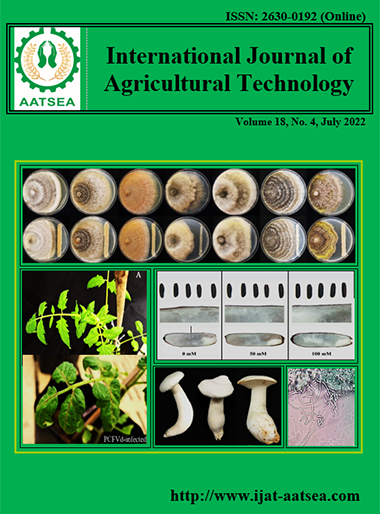Community participation in the special efforts to increase rice production program (UPSUS) in Ambarawa Pringsewu Regency, Lampung, Indonesia
Main Article Content
Abstract
The Indonesian government in self-sufficiency in rice carried out a Special Effort Program (UPSUS) to increase rice production in Indonesia. To achieve sustainable self-sufficiency in rice, extension workers, students and village supervisory officers (babinsa) are important elements in mobilizing the main actor farmers to be able to apply technology. Extension workers, students and Babinsa are one of the driving factors for farmers (main actors) and can play an active role as communicators, facilitators, advisors, motivators, educators, organizers and dynamists in the context of implementing special efforts to increase rice production. The results showed that the level of farmers participation in the UPSUS program was in middle classification, the factors that related to farmers participation were knowledge of UPSUS program, the frequency of attending the extension activity, the level of farmer motivation, and cosmopolite character. The age, the level of formal education, and the large number of landowners were not related to farmer participation, and there was a correlation between farmers participation in UPSUS programs and the rice productivity in Ambarawa Sub-district. The results showed that the frequency of extension activities has a strong relationship with Farmer Participation in the UPSUS. This implies that more and more farmer activities have an impact on improving the UPSUSprogram. This program will be successful if it is supported by the land area owned by the farmers. Other findings in this study were age, and formal education were not associated with the success of the UPSUS Pajale program. This means that the success of the program does not depend on the education and age of the farmers, because most of the farmers do not have formal education and the average age is in the older group.
Article Details

This work is licensed under a Creative Commons Attribution-NonCommercial-NoDerivatives 4.0 International License.
References
Aref, F. (2011). Farmers’ participation in agricultural development: The case of Fars province, Iran. Indian Journal of Science and Technology, 4:155-158.
Chitambo, B. R., Smith, J. E. and Ehlers, V. J. (2002). Strategies for community participation in developing countries. Curationis, 25:76-83.
Forsyth, M. (2014). Community development investment review: Creative placemaking. Federal Reserve Bank of San Francisco, 10:87-98.
Fukugawa, N., Ambashi, M. and Suhud, Y. (2018). Division of Labour Amongst Innovation Intermediaries in Agricultural Innovation Systems : The Case of Indonesia. Eria Discussion Paper Sieries, 6:1-53.
Ghimire, N. R. (2009). Farmer participation in agricultural development in Nepal: A case study. Journal of Agricultural, Food, and Environmental Sciences, 3:1-12.
Heck, B. van. (2003). Participatory development: guidelines on beneficiary participation in agricultural and rural development. In Food and Agriculture Organization of the United Nations (p.83).
Indraningsih, K. S. (2011). Effects of Extension to Farmers ’ Decision in Adopting Integrated Farming Technology. Agro Ekonomi, 29:1-24.
Kraska-Miller, M. (2014). NonParametric statistics for social and behavioral sciences.Taylor & Francis Group, 250 p
Kuehne, G., Llewellyn, R., Pannell, D. J., Wilkinson, R., Dolling, P., Ouzman, J. and Ewing, M. (2017). Predicting farmer uptake of new agricultural practices: A tool for research, extension and policy. Agricultural Systems, 156:115-125.
Listiana, I. (2010). Penggemukan sapi potong antara PT. Great giant livestock company ( GGLC) PT . Great giant livestock company ( GGLC).
Listiana, I., Sadono, D. and Tjiptopranoto, P. (2018a). The relation between extention worker’s capacity and the level of farmer’s satisfaction in extention activity. Jurnal Penyuluhan, 14:244-256.
Listiana, I., Sumardjo, Sadono, D. and Tjitropranoto, P. (2018b). Affecting Factors the Capacity of Freelance Extension Agents and Its Impacts on Farmers. International Journal of Business and Social Science, 9:137-145.
Listiana, I., Sumardjo., Sadono, D., Tjiptopranoto, P. and Ariyanto, D. (2019). Internet usage in agricultural extensionactivities in Lampung Province, Indonesia. International Journal of Innovative Technology and Exploring Engineering, 8:1486-1493.
Madon, S., Malecela, M. N., Mashoto, K., Donohue, R., Mubyazi, G. and Michael, E. (2018). The role of community participation for sustainable integrated neglected tropical diseases and water, sanitation and hygiene intervention programs: A pilot project in Tanzania. Social Science and Medicine, 202:28-37.
Mubita, A., Libati, M. and Mulonda, M. (2017). The Importance and Limitations of Participation in Development Projects and Programmes. European Scientific Journal, 13:238.
Nikkhah, H. A. and Redzuan, M. (2009). Participation as a medium of empowerment in community development. European Journal of Social Sciences, 11:170-176.
Prasmatiwi, F., Listiana, I. and Rosanti, N. (2012). Pengaruh intensifikasi pertanian terhadap ketahanan pangan rumah tangga petani padi di lampung tengah. In: Seminar Nasional sains Matematika Informatika dan Aplikasinya III, 978:98559.
Quincieu, E. (2015). Summary of Indonesia’s agriculture, natural resources, and environment sector assessment. ADB Paper on Indonesia, 08:1-7.
Sitopu, R., Fauzia, L. and Jufri. (2014). Farmers participation in the application of organic rice farming (case study in lubuk bayas village, perbaungan district, serdang bedagai regency. Journal on Social Economic of Agriculture and Agribusiness, 3:1-11.


